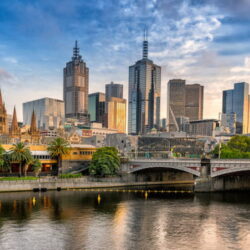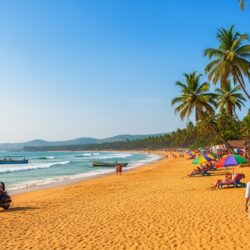Perched at over 10,000 feet above sea level, Ladakh is a land of dramatic contrasts—where snow-draped peaks meet golden deserts, and silence speaks louder than words. Ladakh Tourism has emerged as a magnet for travelers seeking raw beauty, spiritual depth, and adrenaline-fueled adventures. Whether you’re riding through mountain passes, meditating in centuries-old monasteries, or camping beside turquoise lakes, Ladakh promises an experience that lingers long after the journey ends.
📍 Leh: The Cultural and Adventure Capital
Leh, the heart of Ladakh, is where most journeys begin.
- Leh Palace: A 17th-century palace offering panoramic views of the town and surrounding mountains.
- Shanti Stupa: A white-domed stupa built by Japanese monks, especially stunning at sunset.
- Main Bazaar: A bustling street for Tibetan handicrafts, prayer flags, and local cuisine.
- Hall of Fame: A museum honoring Indian soldiers, especially those who served in the Kargil War.
Leh is the gateway to Ladakh Tourism, offering acclimatization, cultural immersion, and logistical ease.
🏞️ Nubra Valley: Desert in the Sky
Accessible via the iconic Khardung La Pass, Nubra Valley is a high-altitude desert with a unique charm.
- Diskit Monastery: Home to a towering statue of Maitreya Buddha and sweeping valley views.
- Hunder Sand Dunes: Ride Bactrian camels across the cold desert.
- Turtuk: A culturally rich village near the Indo-Pak border, known for apricots and Balti heritage.
- Panamik: Famous for its hot springs and proximity to the Siachen Glacier base.
Nubra is a highlight of Ladakh Tourism, offering a rare blend of desert, culture, and Himalayan vistas.
🌊 Pangong Lake: A Cinematic Wonder
Made famous by Bollywood, Pangong Tso is a high-altitude lake that stretches from India into China.
- Altitude: Over 14,000 feet.
- Color Shifts: The lake changes hues from blue to green to grey depending on the light.
- Camping: Stay in eco-camps or homestays along the lake’s edge.
- Stargazing: With minimal light pollution, the night sky is a spectacle.
Pangong is one of the most photographed Ladakh Tourism icons, drawing travelers year-round.
🏔️ Tso Moriri and Tso Kar: Remote and Pristine
These lesser-known lakes offer solitude and raw Himalayan beauty.
- Tso Moriri: A tranquil lake in the Changthang region, surrounded by snow-capped peaks.
- Tso Kar: A salt lake known for birdwatching, especially black-necked cranes.
- Korzok Village: One of the world’s highest settlements, located near Tso Moriri.
These lakes are ideal for those seeking offbeat Ladakh Tourism experiences.
🛕 Monasteries and Spiritual Retreats
Ladakh is deeply spiritual, with Tibetan Buddhism shaping its culture and architecture.
- Hemis Monastery: The largest and wealthiest monastery, known for its annual Hemis Festival.
- Thiksey Monastery: A 12-story complex resembling the Potala Palace in Lhasa.
- Alchi Monastery: Renowned for its ancient murals and Indo-Tibetan art.
- Lamayuru Monastery: Set against a moonscape, it’s one of the oldest gompas in Ladakh.
These monasteries are spiritual anchors of Ladakh Tourism, offering peace, history, and cultural insight.
🧗♂️ Adventure Activities in Ladakh
Ladakh is a playground for thrill-seekers.
- Trekking: Popular routes include Markha Valley, Chadar Trek (on frozen Zanskar River), and Stok Kangri.
- Mountain Biking: Ride through Khardung La, one of the world’s highest motorable passes.
- River Rafting: Conquer the rapids of the Zanskar and Indus Rivers.
- Motorbiking: The Leh-Manali and Leh-Srinagar highways are legendary among bikers.
Adventure is a core pillar of Ladakh Tourism, drawing enthusiasts from across the globe.
🏘️ Offbeat Villages and Cultural Immersion
Beyond the popular circuits, Ladakh hides many cultural gems.
- Hanle: Home to India’s highest astronomical observatory.
- Basgo and Likir: Known for ancient forts and monasteries.
- Chilling and Sumda Chun: Artisan villages famous for metalwork and heritage homestays.
- Zanskar Valley: A remote region with dramatic landscapes and deep-rooted traditions.
These places offer a deeper, slower side of Ladakh Tourism, ideal for cultural travelers.
🧭 Suggested Itinerary (7 Days)
Day 1: Arrive in Leh, rest and acclimatize
Day 2: Explore Leh Palace, Shanti Stupa, and local markets
Day 3: Drive to Nubra Valley via Khardung La, stay in Hunder
Day 4: Visit Diskit Monastery and Turtuk, return to Leh
Day 5: Drive to Pangong Lake, overnight stay
Day 6: Return to Leh via Chang La Pass
Day 7: Optional trip to Hemis and Thiksey Monasteries
This itinerary offers a balanced taste of Ladakh Tourism—culture, adventure, and natural beauty.
💡 Travel Tips
- Best Time to Visit: May to September for road access; January–February for winter treks.
- Altitude Caution: Acclimatize for 24–48 hours in Leh before heading to higher altitudes.
- Permits: Required for Pangong, Nubra, and Tso Moriri—available online or via local agents.
- Connectivity: Limited mobile and internet access; BSNL and Jio work best.
- Sustainability: Carry reusable bottles, avoid plastic, and respect local customs.
Ladakh Tourism is increasingly focused on responsible travel—supporting local communities and preserving fragile ecosystems.
Final Thoughts
Ladakh Tourism is not just about visiting a destination—it’s about experiencing a different rhythm of life. It’s where the silence of the mountains speaks louder than words, and every turn reveals a new wonder. Whether you’re a biker chasing high passes, a pilgrim seeking peace, or a traveler yearning for untouched beauty, Ladakh welcomes you with open skies and ancient wisdom.




